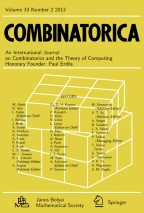Abstract
Recently, Razborov obtained superpolynomial lower bounds for monotone circuits that cliques in graphs. In particular, Razborov showed that detecting cliques of sizes in a graphm vertices requires monotone circuits of size Ω(m s/(logm)2s) for fixeds, and sizem Ω(logm) form/4].
In this paper we modify the arguments of Razborov to obtain exponential lower bounds for circuits. In particular, detecting cliques of size (1/4) (m/logm)2/3 requires monotone circuits exp (Ω((m/logm)1/3)). For fixeds, any monotone circuit that detects cliques of sizes requiresm)s) AND gates. We show that even a very rough approximation of the maximum clique of a graph requires superpolynomial size monotone circuits, and give lower bounds for some Boolean functions. Our best lower bound for an NP function ofn variables is exp (Ω(n 1/4 · (logn)1/2)), improving a recent result of exp (Ω(n 1/8-ε)) due to Andreev.
Similar content being viewed by others
7. References
A. V. Aho, J. E. Hopcroft, andJ. D. Ullman,The Design and Analysis of Computer Algorithms, Addison—Wesley, Reading, 1974.
A. E. Andreev, On a method for obtaining lower bounds for the complexity of individual monotone functions,Dokl. Ak. Nauk. SSSR 282 (1985), 1033–1037 (in Russian). English translation inSov. Math. Dokl. 31 (1985), 530–534.
P. A. Bloniarz,The complexity of monotone Boolean functions and an algorithm for finding shortest paths in a graph, Ph. D. Dissertation, Technical Report238, Laboratory for Computer Science, Massachusetts Institute of Technology, 1979.
N. Blum, A Boolean function requiring 3n network size,Theoretical Computer Science 28 (1984), 337–345.
F. Chung andR. M. Karp,in: Open problems proposed at the NSF Conf. on Complexity Theory, Eugene, Oregon 1984,SIGACT News 16 (1984), 46.
P. Erdős andR. Rado, Intersection theorems for systems of sets,Journal of London Mathematical Society 35 (1960), 85–90.
J. E. Hopcroft andR. M. Karp, Ann 5/2 algorithm for maximum matching in bipartite graphs,SIAM Journal on Computing 4 (1973), 225–231.
K. Mehlhorn andZ. Galil, Monotone switching circuits and Boolean matrix product,Computing 16 (1976), 99–111.
J. Nešetřil andS. Poljak, On the complexity of the subgraph problem,CMUC 26 (1985), 415–419.
M. S. Paterson, Complexity of monotone networks for Boolean matrix products,Theoretical Computer Science 1 (1975), 13–20.
V. R. Pratt, The power of negative thinking in multiplying Boolean matrices,SIAM Journal on Computing 4 (1974), 326–330.
A. A. Razborov, Lower bounds for the monotone complexity of some Boolean functions,Dokl. Ak. Nauk. SSSR,281, (1985), 798–801 (in Russian). English translation in:Sov. Math. Dokl.,31 (1985), 354–357.
A. A. Razborov, Lower bounds on monotone network complexity of the logical permanent,Mat. Zametki,37 (1985), 887–900 (in Russian). English translation in:Math. Notes of the Academy of Sciences of the USSR 37 (1985), 485–493.
C. E. Shannon, The synthesis of two-terminal switching circuits,Bell System Technical Journal,28 (1949), 59–98.
S. Skyum andL. G. Valiant, A complexity theory based on Boolean algebra,Journal of the ACM,32:2 (1985), 484–502.
J. Tiekenheinrich, A 4n-lower bound on the monotone network complexity of a one-output Boolean function,Information Processing Letters,18 (1984), 201–202.
L. G. Valiant, Completeness classes in algebra,Proceedings of 11 th ACM Symposium on Theory of Computing, (1979), 249–261.
I. Wegener, Boolean functions whose monotone complexity is of sizen 2/logn, Theoretical Computer Science,21 (1982), 213–224.
Author information
Authors and Affiliations
Additional information
First author supported in part by Allon Fellowship, by Bat Sheva de-Rotschild Foundation by the Fund for basic research administered by the Israel Academy of Sciences.
Second author supported in part by a National Science Foundation Graduate Fellowship.
